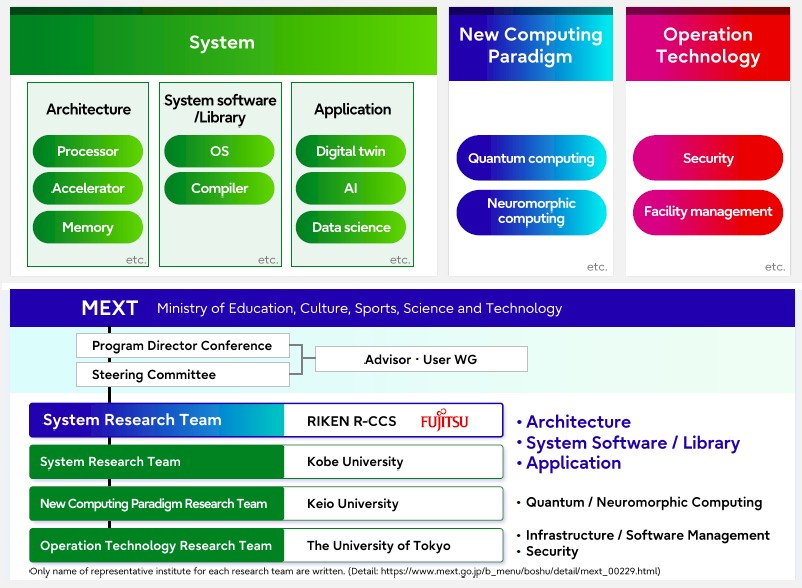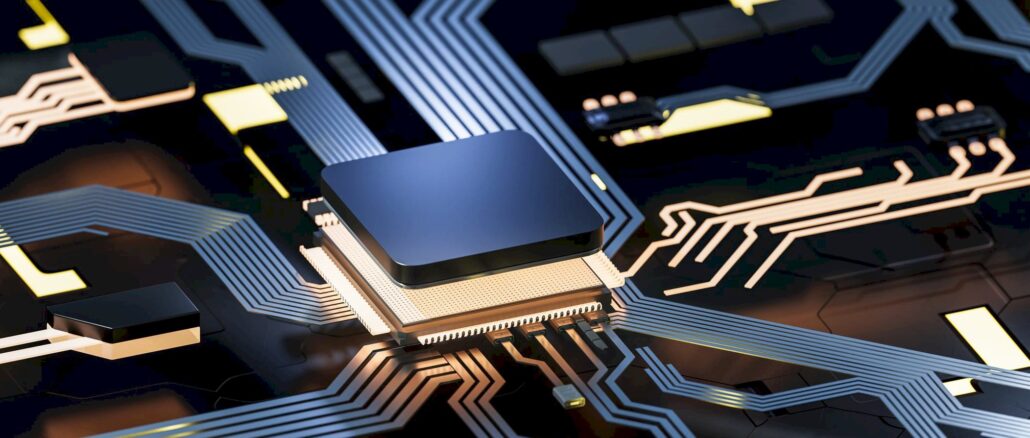The kicker is a successor that implements an structure and design and that features microarchitecture enhancements to spice up core efficiency (core within the twin meanings of that phrase with regards to CPUs) in addition to profiting from chip manufacturing processes (and now packaging) to scale the efficiency additional in a socket.
The fork is a divergence of some type, actually a fork within the highway that makes all of the distinction as Robert Frost would possibly say. There could be compatibility – such because the variations between massive and little cores within the Arm, Energy, and now X86 markets. Intel and AMD are going to be implementing big-little core methods of their server CPU strains this yr, AMD in its “Bergamo” Epycs and Intel in its “Sierra Forest” Xeon SPs. Intel has had X86 appropriate Atom and Xeon chips and now E and P cores for a decade and a half, so this isn’t exactly new to the world’s largest CPU maker.
And this sort of fork is what we expect Japanese CPU and system maker Fujitsu might be doing with its future “Monaka” and “Fugaku-Subsequent” processors, the previous of which was revealed just lately and the latter of which went onto the whiteboards with pungent markers – effectively, it was the start of a feasibility examine by the Japanese Ministry of Schooling, Tradition, Sports activities, Science, and Expertise, with Schooling, Tradition, Sports activities, Science being a variable X and thus making up the abbreviation MEXT – again in August 2022.
Fujitsu has been a good accomplice of the RIKEN Lab, the nation’s pre-eminent HPC analysis middle, for the reason that design of the $1.2 billion “Keisuko” Okay supercomputer, which started in 2006 to interrupt the ten petaflops barrier in 64-bit precision floating level processing and which was delivered in 2011. Design on the follow-on the $910 million, 513.9 petaflops “Fugaku” supercomputer, which noticed Fujitsu swap from its Sparc64 structure to a customized, vector-turbocharged Arm structure, began in 2012. The Fugaku system was delivered in June 2020, was absolutely operational in 2021, and work on the Fugaku-Subsequent system began a yr later, proper on schedule.

Based on the roadmap put out by Fujitsu and RIKEN Lab at SC22 final November, the plan is for the Fugaku-Subsequent machine to be operational “round 2030,” and that timing is vital (we’ll get into that in a second).
Listed here are the analysis concepts being tackled and the know-how embodied in Fugaku-Subsequent and who’s doing the tackling:

All the concepts you’d anticipate in a machine being put in in six or seven years are there – a mixture of conventional HPC and AI and the addition of quantum and neuromorphic computing. Supercomputers sooner or later might be highly effective, little question, however it could be higher referred to as “circulate computing” greater than “tremendous computing” as a result of there might be a mixture of totally different sorts of compute and purposes comprised of workflows of various smaller purposes working in live performance, both in a serial method or in iterative loops.
Considerably, Fujitsu and RIKEN are emphasizing “compatibility with the present ecosystem” and “heterogeneous techniques related by excessive bandwidth networks.” Fujitsu says additional that the structure of the Fugaku-Subsequent system will use rising excessive density packaging, have vitality environment friendly and excessive efficiency accelerators, low latency and excessive bandwidth reminiscence.
If historical past is any information, and with Japanese supercomputers it completely is, then a machine is put in within the yr earlier than it goes operational, which implies Fugaku-Subsequent might be put in in “round 2029” or so.
Preserve that each one in thoughts as we take a look at the “Monaka” CPU that Fujitsu is engaged on below the auspices of the Japanese authorities’s New Vitality and Industrial Expertise Growth Group (NEDO). On the finish of February, Fujitsu, NEC, AIO Core, Kioxia, and Kyocera had been all tapped to work on extra vitality environment friendly datacenter processing and interconnects. Particularly, the NEDO effort needs to have vitality environment friendly server CPUs and photonics-boosts SmartNICs.
Inside this effort, it appears like Fujitsu is making a by-product of the A64FX Arm processor on the coronary heart of the Fugaku system, however persons are conflating this with that means that Monaka is the follow-on processor that might be used within the Fugaku-Subsequent system.
That is exactly what was stated: “Fujitsu will additional refine this know-how and develop a low-power consumption CPU that can be utilized in next-generation inexperienced datacenters.”
Listed here are the duties assigned to the NEDO companions:
- Fujitsu: Growth of low-power consumption CPUs and photonics sensible NIC
- NEC: Growth of low-power consumption accelerators and disaggregation applied sciences
- AIO Core: Growth of photoelectric fusion gadgets
- Kioxia: Growth of Wideband SSD
- Fujitsu Optical Parts: Growth of photonics sensible NIC
- Kyocera: Growth of photonics sensible NIC
The Monaka CPU is due in 2027 and goals to provid larger efficiency at decrease vitality consumption:

How it will occur is unclear, however the implication is that will probably be an Arm-based server processor, however one optimized for hyperscalers and cloud builders and never for HPC and AI facilities. That ought to imply extra cores and fewer vector processing relative to A64FX (or somewhat, the kicker to A64FX in Fugaku-Subsequent system) and really doubtless the addition of low-precision matrix math models for AI inference. One thing conceptually like Intel’s “Sapphire Rapids” Xeon SPs and future AMD Epyc processors with Xilinx DSP AI engines when it comes to capabilities, however with an Arm core and a deal with vitality effectivity, a lot larger efficiency per watt.
In actual fact, as Fujitsu appears forward to 2027, when Monaka will go into manufacturing techniques, it says will probably be capable of ship 1.7X the applying efficiency and 2X the efficiency per watt of “One other – 2027” CPU, no matter that could be.
The complicated bit, which has led some folks to consider that Monaka is the processor that would be the kicker to A64FX and used within the Fugaku-Subsequent systen, is that this sentence: “Not solely boosting conventional HPC workloads, but in addition offering excessive efficiency for AI & Knowledge Analytical workloads.”
However right here is the factor, which we level out typically:HPC is about getting efficiency at any price, and hyperscalers and cloud builders have to get the perfect cheap efficiency on the lowest price and lowest energy.
These are very totally different design factors, and when you can construct HPC within the cloud, you’ll be able to’t construct a cloud optimized for working Internet purposes and anticipate it to do effectively on HPC simulation and modeling and even AI coaching workloads. And vice versa. An HPC cluster wouldn’t be optimized for low price and low energy and could be a foul selection for Internet purposes. You possibly can promote actual HPC techniques below a cloud mannequin, in fact, by placing InfiniBand and fats nodes with a number of GPUs in 20 p.c of the nodes in a cloud, however it’s by no means going to be as low-cost because the plain vanilla cloud infrastructure, which has that totally different design level.
With Fugaku-Subsequent being a heterogeneous, “circulate pc” type of supercomputer, it is vitally cheap to assume {that a} kicker to the Monaka Arm CPU geared toward cloud infrastructure might find yourself within the Fugaku-Subsequent system. However that’s not the identical factor as saying there won’t be a successor to A64FX, which researchers have already proven can have its efficiency boosted by 10X by 2028 with large quantities of stacked L3 cache and course of shrinks on the Arm cores. That’s with no architectural enhancements on the A64FX cores, and you understand there might be tweaks right here.
We predict it’s much more doubtless {that a} successor to Monaka, which we might anticipate in 2029 given a two yr processor cadence, might be included in Fugaku-Subsequent, however that there’s little or no likelihood will probably be the only CPU within the system – except the economic system tanks and MEXT and NEDO need to share cash.
The Nice Recession tousled the unique “Keisuko” venture, which had Fujitsu doing a scalar CPU, NEC doing a vector CPU, and Hitachi doing the torus interconnect we now know as Tofu. NEC and Fujitsu backed out as a result of the venture was too costly and they didn’t assume the know-how might be commercialized sufficient to cowl the prices. Fujitsu took over the venture and delivered brilliantly, however we suspect that earning money from Sparc64fx and A64FX has been tough.
However, with authorities backing, as Fujitsu has due to its relationship with RIKEN, and Japan’s need to be unbiased with regards to its quickest supercomputer, none of that issues. What was true in 2009 concerning the worth of provide chain independence (which many international locations ignored for the sake of ease and decrease price supercomputers) is much more true in 2029.
Fujitsu is just not being particular, and Satoshi Matsuoka, director of RIKEN Lab and a professor at Tokyo Institute of Expertise, commented on the studies that Monaka was being utilized in Fugaku-Subsequent machine in his Twitter feed thus: “Nothing has been determined but whether or not Monaka will energy #FugakuNEXT; it’s actually one of many technical parts into consideration.” However he additionally added this: “Since #HPC(w/AI, BD) is not a distinct segment market, the purpose is to not create a singleton ***scale machine, however S&T platforms that may span throughout SCs, clouds and many others. For that function, SW generality & market penetratability esp. to hyperscalars are should. We are going to accomplice w/distributors sharing the identical imaginative and prescient.”
We predict there might be two Arm CPUs utilized in Fugaku-Subsequent: One keyed to AI inference and generic CPU workloads and one tuned to do actually arduous HPC simulation and AI coaching. Name them A64FX2 and Monaka2 if you’d like. The one approach there might be one chip is that if the finances compels it, simply as occurred with the Okay machine.






